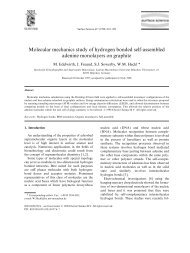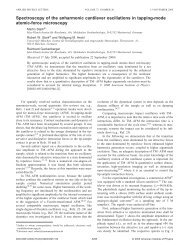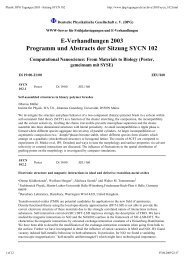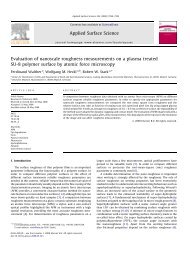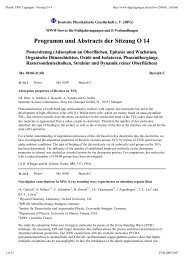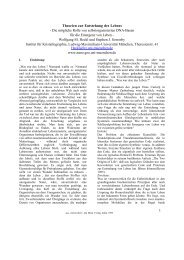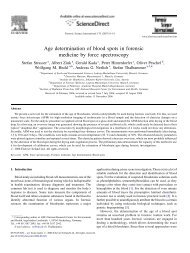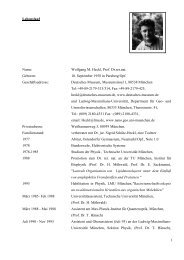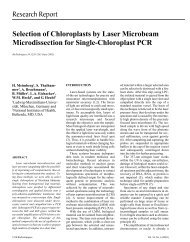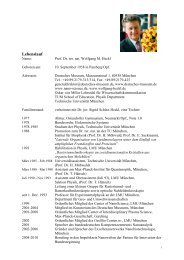Physik: DPG Tagungen - Sitzung O 28 - Nano-science.de
Physik: DPG Tagungen - Sitzung O 28 - Nano-science.de
Physik: DPG Tagungen - Sitzung O 28 - Nano-science.de
You also want an ePaper? Increase the reach of your titles
YUMPU automatically turns print PDFs into web optimized ePapers that Google loves.
<strong>Physik</strong>: <strong>DPG</strong> <strong>Tagungen</strong> - <strong>Sitzung</strong> O <strong>28</strong><br />
http://www.dpg-tagungen.<strong>de</strong>/archive/2004/o_<strong>28</strong>.html<br />
•Sebastian Thiess 1 , Tien-Lin Lee 1 , Bruce C. C. Cowie 1 , Joe C. Woicik 2 und Jörg Zegenhagen 1<br />
1 ESRF, Grenoble, France<br />
2 NIST, Gaithersburg, USA<br />
We used the x-ray standing waves (XSW) technique and x-ray photoelectron spectroscopy (XPS) to <strong>de</strong>termine<br />
the contribution of the constituent elements Sr, Ti and O of a SrTiO 3 (STO) crystal to the STO valence band,<br />
thus <strong>de</strong>riving their partial <strong>de</strong>nsity of states.<br />
Lattice site-specific electronic information - which is not available from standard XPS - is obtained by utilising<br />
the spatial intensity modulation of an x-ray standing wave (XSW) interference field, generated by the coherent<br />
superposition of an inci<strong>de</strong>nt and a Bragg-reflected x-ray beam. By proper positioning the antino<strong>de</strong>s of the XSW<br />
within the STO unit cell, photoemission from specific lattice sites can be preferentially excited and their valence<br />
electronic contribution i<strong>de</strong>ntified.<br />
XSW fields were generated by the STO(111) and STO(112) reflections at photon energies of 2.7 and 3.9 keV.<br />
XSW modulated, high-resolution core and valence-electron emission spectra were recor<strong>de</strong>d from an in-situ<br />
UHV annealed STO single crystal at beamline ID32 at the ESRF.<br />
O <strong>28</strong>.13 Poster Mi 16:00 Bereich C<br />
Mechanisms and capability of Steam Laser Cleaning<br />
•F. Lang 1 , M. Mosbacher 1 , S. Georgiou 2 und P. Lei<strong>de</strong>rer 1<br />
1 University of Konstanz, Fach M676, 78457 Konstanz, Germany<br />
2 FORTH - IESL, P.O. Box 1527, 71110 Heraklion, Greece<br />
Steam Laser Cleaning is a powerful approach to remove submicron particles from surfaces. In the first step a<br />
liquid is applied onto the contaminated surface. Afterwards a laser pulse heats part of the fluid to a superheated<br />
state resulting in bubble nucleation and growth. Thereby strong forces are exerted on the contaminants, which<br />
are able to overcome the adhesion of the particles to the surface.<br />
Our measurements covering a broad range of particle sizes <strong>de</strong>monstrated the existence of a universal cleaning<br />
threshold for the laser fluence. In addition the influence of different liquid layer thicknesses was explored.<br />
Investigations of the surfaces after cleaning verified for the first time that damage free removal can be achieved,<br />
if the experimental parameters are chosen properly. Moreover fundamental studies of the bubble nucleation and<br />
growth in the superheated liquid were conducted to gain a more <strong>de</strong>tailed un<strong>de</strong>rstanding of the phase transition<br />
dynamics.<br />
O <strong>28</strong>.14 Poster Mi 16:00 Bereich C<br />
In-situ Vi<strong>de</strong>o-STM Untersuchung <strong>de</strong>r Dynamik von Sulfidadsorbaten auf Cu(100)-Elektro<strong>de</strong>n<br />
•Tunay Tansel und Olaf Magnussen<br />
Institut für Experimentelle und Angewandte <strong>Physik</strong> Christian-Albrechts-Universität Kiel<br />
Die Diffusion und Wechselwirkung von Adsorbaten an Elektro<strong>de</strong>noberflächen ist von großer Be<strong>de</strong>utung für das<br />
Verständnis <strong>de</strong>r elektrochemischen Phasengrenze. Solche dynamischen Prozesse wur<strong>de</strong>n hier am Beispiel von<br />
Sulfidadsorbaten (Be<strong>de</strong>ckungen 0,01 bis 0,03ML) auf Cu(100) in 0,01M HCl mittels elektrochemischer<br />
Hochgeschwindigkeits- Rastertunnelmikroskopie (Vi<strong>de</strong>o-STM) direkt auf <strong>de</strong>r atomaren Skala untersucht. Eine<br />
statistische Analyse <strong>de</strong>r Diffusion isolierter S ad ergab Sprungfrequenzen im Bereich von ? 2·10 -1 Hz. An <strong>de</strong>n<br />
Domänengrenzen c(2x2)-Phase ist die S ad Mobilität jedoch stark erhöht. Dies zeigt, dass die Gegenwart <strong>de</strong>s<br />
c(2x2)-Cl Koadsorbatgitters die effektive Diffusionsbarriere von S ad <strong>de</strong>utlich vergrößert. Weiterhin weisen die<br />
Beobachtungen auf attraktive S ad -S ad Wechselwirkungen und eine erhöhte Mobilität von Clustern an mehreren,<br />
benachbarten S ad hin.<br />
5 of 32 07.06.2009 22:14



